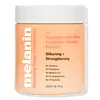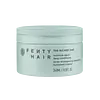What's inside
What's inside
 Key Ingredients
Key Ingredients

 Benefits
Benefits

 Concerns
Concerns

 Ingredients Side-by-side
Ingredients Side-by-side

Water
Skin ConditioningDiheptyl Succinate
EmollientCapryloyl Glycerin/Sebacic Acid Copolymer
Skin ConditioningBehentrimonium Methosulfate
Glycerin
HumectantCetearyl Alcohol
EmollientPanthenol
Skin ConditioningAloe Barbadensis Leaf Juice
Skin ConditioningSimmondsia Chinensis Seed Oil
EmollientArgania Spinosa Kernel Oil
EmollientHydrolyzed Pea Protein
EmollientHydrolyzed Vegetable Protein
Skin ConditioningMusa Sapientum Flower Extract
Skin ConditioningCucurbita Pepo Seed Oil
EmollientCymbopogon Flexuosus Oil
MaskingPelargonium Graveolens Flower Oil
MaskingMentha Piperita Oil
MaskingCitrus Aurantifolia Oil
CleansingSalvia Officinalis Oil
MaskingCitrus Aurantium Bergamia Peel Oil
Salvia Sclarea Oil
MaskingZingiber Officinale Root Oil
MaskingCannabis Sativa Seed Oil
EmollientTrigonella Foenum-Graecum Seed Extract
PerfumingCamellia Sinensis Leaf Extract
AntimicrobialBiotin
AntiseborrhoeicSodium Hyaluronate
HumectantHydrolyzed Adansonia Digitata Seed Extract
Bambusa Vulgaris Extract
Skin ConditioningCaprylhydroxamic Acid
Caprylyl Glycol
EmollientCitric Acid
BufferingWater, Diheptyl Succinate, Capryloyl Glycerin/Sebacic Acid Copolymer, Behentrimonium Methosulfate, Glycerin, Cetearyl Alcohol, Panthenol, Aloe Barbadensis Leaf Juice, Simmondsia Chinensis Seed Oil, Argania Spinosa Kernel Oil, Hydrolyzed Pea Protein, Hydrolyzed Vegetable Protein, Musa Sapientum Flower Extract, Cucurbita Pepo Seed Oil, Cymbopogon Flexuosus Oil, Pelargonium Graveolens Flower Oil, Mentha Piperita Oil, Citrus Aurantifolia Oil, Salvia Officinalis Oil, Citrus Aurantium Bergamia Peel Oil, Salvia Sclarea Oil, Zingiber Officinale Root Oil, Cannabis Sativa Seed Oil, Trigonella Foenum-Graecum Seed Extract, Camellia Sinensis Leaf Extract, Biotin, Sodium Hyaluronate, Hydrolyzed Adansonia Digitata Seed Extract, Bambusa Vulgaris Extract, Caprylhydroxamic Acid, Caprylyl Glycol, Citric Acid
Water
Skin ConditioningCetearyl Alcohol
EmollientEthyl Oleate
EmollientGlycerin
HumectantIsoamyl Laurate
EmollientEthyl Stearate
EmollientBrassicamidopropyl Dimethylamine
Skin ConditioningGlyceryl Ricinoleate
EmollientHydrolyzed Vegetable Protein
Skin ConditioningPereskia Aculeata Callus Extract
Panthenol
Skin ConditioningCamellia Sinensis Leaf Extract
AntimicrobialAlanine
MaskingArginine
MaskingAspartic Acid
MaskingGlycine
BufferingHistidine
HumectantIsoleucine
Skin ConditioningPhenylalanine
MaskingProline
Skin ConditioningSerine
MaskingTartaric Acid
BufferingThreonine
Valine
MaskingButyrospermum Parkii Butter Unsaponifiables
Skin ConditioningIrvingia Gabonensis Kernel Butter
Skin ConditioningLactobacillus Ferment
Skin ConditioningMomordica Cochinchinensis Seed Extract
Skin ConditioningPCA
HumectantRicinus Communis Seed Oil
MaskingSodium PCA
HumectantVaccinium Myrtillus Seed Oil
Skin ConditioningEthyl Linoleate
EmollientEthyl Palmitate
EmollientHydrogenated Coco-Glycerides
EmollientHydroxypropylgluconamide
HumectantMyristyl Myristate
EmollientOctyldodecanol
EmollientPropanediol
SolventPolyquaternium-113
Guar Hydroxypropyltrimonium Chloride
Skin ConditioningHydroxypropylammonium Gluconate
HumectantQuaternium-91
Sodium Lactate
BufferingTocopherol
AntioxidantSodium Metabisulfite
AntioxidantCitric Acid
BufferingSodium Hydroxide
BufferingLactic Acid
BufferingCaprylyl Glycol
EmollientSodium Benzoate
MaskingPotassium Sorbate
PreservativeEthylhexylglycerin
Skin ConditioningBehentrimonium Chloride
PreservativeCetrimonium Chloride
AntimicrobialPhenoxyethanol
PreservativeBenzyl Alcohol
PerfumingParfum
MaskingAlpha-Isomethyl Ionone
PerfumingBenzyl Salicylate
PerfumingCoumarin
PerfumingHexyl Cinnamal
PerfumingLimonene
PerfumingLinalool
PerfumingWater, Cetearyl Alcohol, Ethyl Oleate, Glycerin, Isoamyl Laurate, Ethyl Stearate, Brassicamidopropyl Dimethylamine, Glyceryl Ricinoleate, Hydrolyzed Vegetable Protein, Pereskia Aculeata Callus Extract, Panthenol, Camellia Sinensis Leaf Extract, Alanine, Arginine, Aspartic Acid, Glycine, Histidine, Isoleucine, Phenylalanine, Proline, Serine, Tartaric Acid, Threonine, Valine, Butyrospermum Parkii Butter Unsaponifiables, Irvingia Gabonensis Kernel Butter, Lactobacillus Ferment, Momordica Cochinchinensis Seed Extract, PCA, Ricinus Communis Seed Oil, Sodium PCA, Vaccinium Myrtillus Seed Oil, Ethyl Linoleate, Ethyl Palmitate, Hydrogenated Coco-Glycerides, Hydroxypropylgluconamide, Myristyl Myristate, Octyldodecanol, Propanediol, Polyquaternium-113, Guar Hydroxypropyltrimonium Chloride, Hydroxypropylammonium Gluconate, Quaternium-91, Sodium Lactate, Tocopherol, Sodium Metabisulfite, Citric Acid, Sodium Hydroxide, Lactic Acid, Caprylyl Glycol, Sodium Benzoate, Potassium Sorbate, Ethylhexylglycerin, Behentrimonium Chloride, Cetrimonium Chloride, Phenoxyethanol, Benzyl Alcohol, Parfum, Alpha-Isomethyl Ionone, Benzyl Salicylate, Coumarin, Hexyl Cinnamal, Limonene, Linalool
Ingredients Explained
These ingredients are found in both products.
Ingredients higher up in an ingredient list are typically present in a larger amount.
Camellia Sinensis Leaf Extract is derived from the leaves of the tea plant. Black tea, green tea, and oolong tea are all harvested from this plant.
This ingredient has many skin benefits:
This ingredient contains polyphenols, a strong antioxidant. Antioxidants help fight off molecules that damage skin cells.
On top of that, the antioxidants in green tea neutralize free-radicals from the sun. This gives the skin some extra UV protection, but should not replace sunscreen.
Many components of tea have anti-inflammatory properties.
Polyphenols and L-theanine help soothe the skin and reduce irritation. The caffeine in Camellia Sinensis Leaf Extract helps calm inflamed blood vessels.
Other compounds found in tea include: Vitamin Bs, linoleic acid, magnesium, calcium, iron, and zinc.
Research has shown both drinking Camellia Sinensis Leaf Tea and applying it to the skin can help boost skin elasticity and hydration. Studies also show using tea extract may reduce sebum, or oil, production.
Learn more about Camellia Sinensis Leaf ExtractCaprylyl Glycol is a humectant and emollient, meaning it attracts and preserves moisture.
It is a common ingredient in many products, especially those designed to hydrate skin. The primary benefits are retaining moisture, skin softening, and promoting a healthy skin barrier.
Though Caprylyl Glycol is an alcohol derived from fatty acids, it is not the kind that can dry out skin.
This ingredient is also used as a preservative to extend the life of products. It has slight antimicrobial properties.
Learn more about Caprylyl GlycolCetearyl alcohol is a mixture of two fatty alcohols: cetyl alcohol and stearyl alcohol. It is mainly used as an emulsifier. Emulsifiers help prevent the separation of oils and products. Due to its composition, it can also be used to thicken a product or help create foam.
Cetearyl alcohol is an emollient. Emollients help soothe and hydrate the skin by trapping moisture.
Studies show Cetearyl alcohol is non-toxic and non-irritating. The FDA allows products labeled "alcohol-free" to have fatty alcohols.
This ingredient is usually derived from plant oils such as palm, vegetable, or coconut oils. There is debate on whether this ingredient will cause acne.
Due to the fatty acid base, this ingredient may not be Malassezia folliculitis safe.
Learn more about Cetearyl AlcoholCitric Acid is an alpha hydroxy acid (AHA) naturally found in citrus fruits like oranges, lemons, and limes.
Like other AHAs, citric acid can exfoliate skin by breaking down the bonds that hold dead skin cells together. This helps reveal smoother and brighter skin underneath.
However, this exfoliating effect only happens at high concentrations (20%) which can be hard to find in cosmetic products.
Due to this, citric acid is usually included in small amounts as a pH adjuster. This helps keep products slightly more acidic and compatible with skin's natural pH.
In skincare formulas, citric acid can:
While it can provide some skin benefits, research shows lactic acid and glycolic acid are generally more effective and less irritating exfoliants.
Most citric acid used in skincare today is made by fermenting sugars (usually from molasses). This synthetic version is identical to the natural citrus form but easier to stabilize and use in formulations.
Read more about some other popular AHA's here:
Learn more about Citric AcidGlycerin is already naturally found in your skin. It helps moisturize and protect your skin.
A study from 2016 found glycerin to be more effective as a humectant than AHAs and hyaluronic acid.
As a humectant, it helps the skin stay hydrated by pulling moisture to your skin. The low molecular weight of glycerin allows it to pull moisture into the deeper layers of your skin.
Hydrated skin improves your skin barrier; Your skin barrier helps protect against irritants and bacteria.
Glycerin has also been found to have antimicrobial and antiviral properties. Due to these properties, glycerin is often used in wound and burn treatments.
In cosmetics, glycerin is usually derived from plants such as soybean or palm. However, it can also be sourced from animals, such as tallow or animal fat.
This ingredient is organic, colorless, odorless, and non-toxic.
Glycerin is the name for this ingredient in American English. British English uses Glycerol/Glycerine.
Learn more about GlycerinWe don't have a description for Hydrolyzed Vegetable Protein yet.
Panthenol is a common ingredient that helps hydrate and soothe the skin. It is found naturally in our skin and hair.
There are two forms of panthenol: D and L.
D-panthenol is also known as dexpanthenol. Most cosmetics use dexpanthenol or a mixture of D and L-panthenol.
Panthenol is famous due to its ability to go deeper into the skin's layers. Using this ingredient has numerous pros (and no cons):
Like hyaluronic acid, panthenol is a humectant. Humectants are able to bind and hold large amounts of water to keep skin hydrated.
This ingredient works well for wound healing. It works by increasing tissue in the wound and helps close open wounds.
Once oxidized, panthenol converts to pantothenic acid. Panthothenic acid is found in all living cells.
This ingredient is also referred to as pro-vitamin B5.
Learn more about PanthenolWater. It's the most common cosmetic ingredient of all. You'll usually see it at the top of ingredient lists, meaning that it makes up the largest part of the product.
So why is it so popular? Water most often acts as a solvent - this means that it helps dissolve other ingredients into the formulation.
You'll also recognize water as that liquid we all need to stay alive. If you see this, drink a glass of water. Stay hydrated!
Learn more about Water